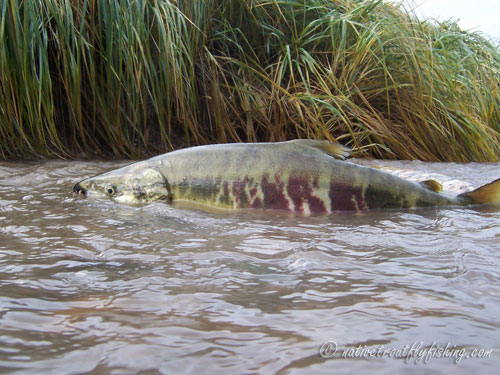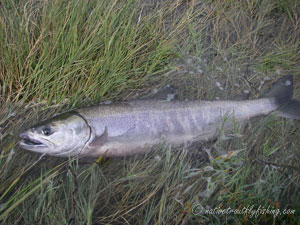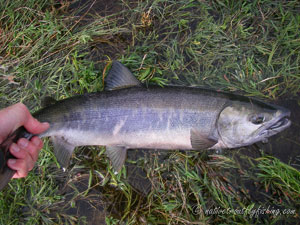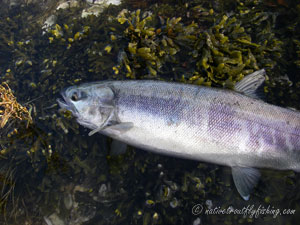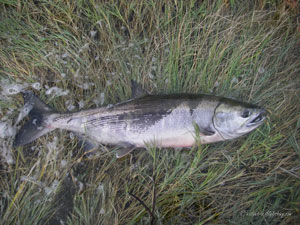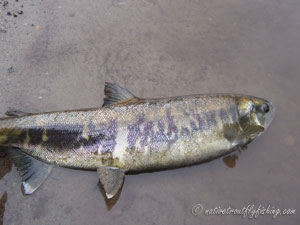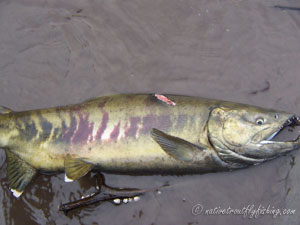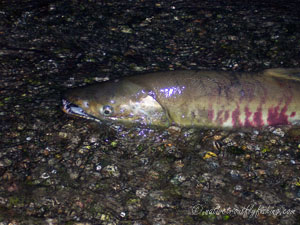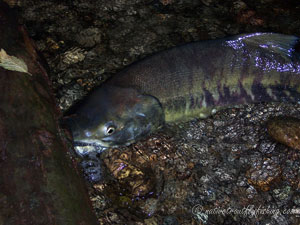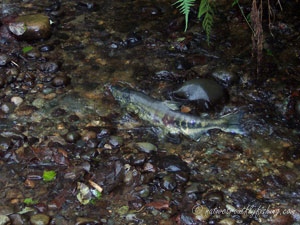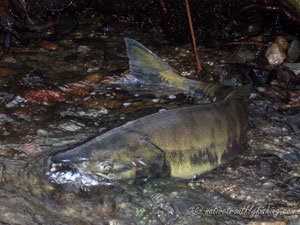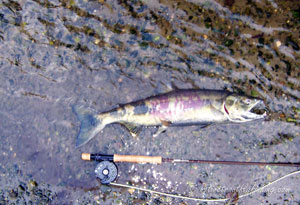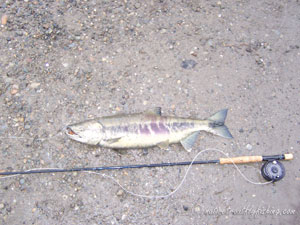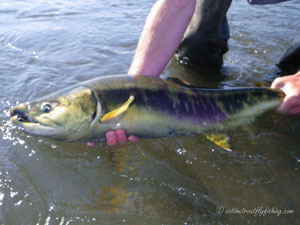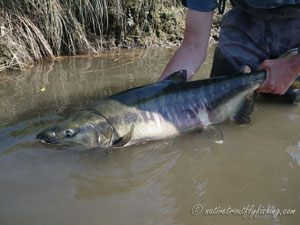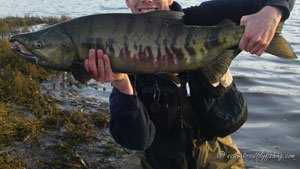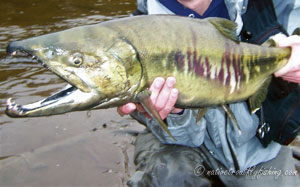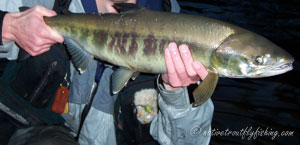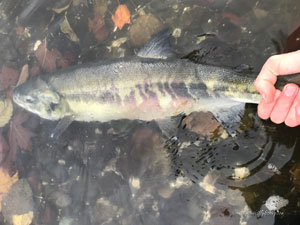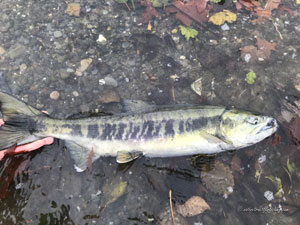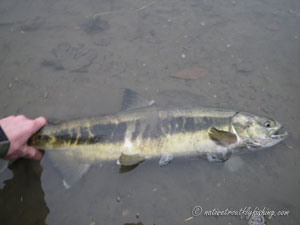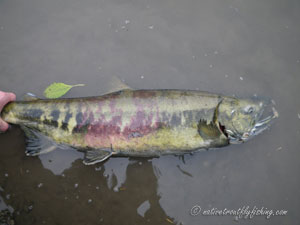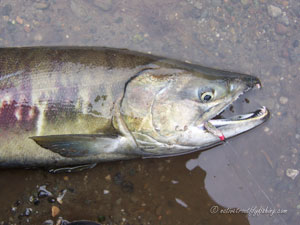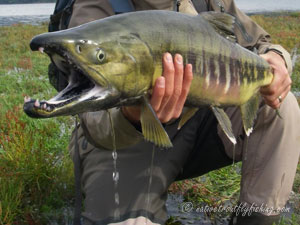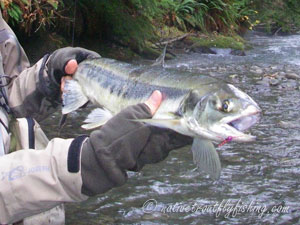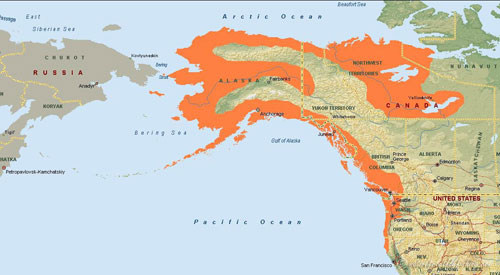Chum Salmon
Oncorhynchus keta
A Puget Sound Chum Salmon returning to spawn
Introduction
Chum or dog salmon are the second largest species of Pacific Salmon and the most abundant in terms of total biomass. Chum Salmon are perhaps one of the least respected species of Pacific Salmon, in part due to their appearance and relatively poor quality as a food fish in comparison to Coho, Chinook and Sockeye.
Life History Information
Chum Salmon have two distinct spawning populations; one which makes a fall spawning run and the other with a summer spawning run. As a general rule, summer runs are more dominant in the northern part of their native range and fall runs are more common in the southern part (Behnke 2002). Summer Chum tend to return to spawn between June and August, and are usually challenged with more difficult conditions for survival. Due to their timing they are often faced with warmer water temperatures and lower flows than the fall spawning fish, making their populations very susceptible to decline or even extinction. Most fall run Chum return to spawn from September to December, but in some rivers, such as the Nisqually of Washington their runs extend into January. This timing generally coincides with the beginning of the rainy season in the Pacific Northwest allowing the salmon to ascend streams that would be too low during other times of the year. Even though Chum Salmon are known to obtain the second largest size of the Pacific Salmon, the individuals of small stream populations are often on the small side. An example of this is a small stream near my house that holds fish averaging only about three or four pounds, while some of the rivers in the area are known to produce fish in excess of twenty pounds. In the southern Puget Sound the bulk of the chum salmon tend to arrive from late October through early December.
Both Chum and Pink Salmon have the lowest dependency on freshwater out of the salmonids (Behnke 2002). These two species of salmon share the ability to successfully spawn in intertidal areas at the mouths of streams, where their eggs are exposed to water that has some degree of salinity. While Chum can spawn in intertidal zones, most do return to freshwater to spawn with some populations making long distance migrations and traveling as far as 1,750 miles up the Yukon River. In the Puget Sound Chum Salmon often exhibit their spawning colors while still in the saltwater well before entering their spawning stream. Spawning chum generally begin to deteriorate within several days to a few weeks of entering fresh water. However populations such as those from the Yukon River which make long spawning runs will often remain bright for some time after entering the freshwater.
Chum Salmon fry usually head out to sea shortly after emerging from their redds when they are just over an inch long. For fall run fish in the southern Puget Sound this usually occurs between February and April. Once in the saltwater, Chum Salmon reside in the estuaries for several months before starting their oceanic migration. Juvenile Chum can generally be found in estuaries through June, and a study onchum in the Fraser River estuary in Canada showed that the size of the fish in the estuary increased as season progressed indicating estuarine residence (Levy and Northcote 1982). After leaving the estuarine waters, Chum Salmon rapidly travel north during their first summer at sea arriving in the Gulf of Alaska in the fall. Chum Salmon mature at between three and five years of age after feeding in the waters of the Gulf of Alaska. While at sea their diet is made up fish, as well invertebrate animals such as jellyfish and ctenophores making them the most specialized feeders of the Pacific salmon (Quinn 2005).
Status
While Chum Salmon have been faced with the same issues as the other species of Pacific salmon, for the most part they have held their own much better than Coho, Chinook and Sockeye throughout much of their native range. While overall Chum Salmon are holding their own, many populations have been lost due to habitat destruction and barriers to migration. Of the four ESUs that have been identified by NOAA fisheries in Washington, Oregon, and California and two are currently considered threatened (Columbia River and the summer Chum of the Hood Canal) (NOAA 2007). Destruction of spawning habitat has been particularly damaging to populations in the Columbia River and the summer chum of the Hood Canal and Puget Sound. Historically the Columbia River held a spawning run of several million chum, but today 10,000 fish is considered a good run. Summer Chum as especially susceptible to habitat destruction due to their run timing and these fish have gone extinct in a number of rivers around the Hood Canal in Washington, including the Tahuya and the Skokomish rivers. However the recovery efforts to bring these fish back have been largely met with success and the summer Chum of the Quilicene and Union rivers are currently making a good come back.
Description
Juvenile Chum Salmon have greenish-olive colored backs and have regular shaped parr marks that are more concentrated above the lateral line. While at sea, Chum Salmon take on a silver coloration with greenish-olive colored backs. Unlike the other Pacific Salmon, Chum lack black spots on their body, dorsal and caudal fins. Another way to differentiate Chum is that their anal and pelvic fins on chum a white tipped. As a general rule, Chum are more deep bodied than other Pacific Salmon, meaning that a Chum that is the same length as a different species of Pacific Salmon would weigh more (Behnke 2002). The average size for a mature Chum is between six and twelve pounds and 24 - 31 inches, although size varies considerably from stream to stream. As spawning approaches, both male and female Chum attain a coloration that consists of black, purple or reddish colored streaks, blotches or bars of on a greenish-olive background. It was this coloration during spawning that has lead to the nick-name of "calico" salmon. Males exhibit large teeth during their spawning phase, which they use to fight for mates. Male Chum tend to be larger than females at the same age and like other salmon have more extreme spawning morphologies including a pronounced kype and dorsal hump.
Fly Fishing Information
Chum Salmon can often be readily taken on flies as they near their spawning streams or once they enter the freshwater. However, as with Coho some staging Chum can be extremely resistant to taking any fly at times. In streams these fish tend to prefer patterns fished at a dead drift or with sporadic twitches. Chum are known to have a preference for the color chartreuse, but colors like pink, purple and black should not be overlooked. In estuarine environments small fast stripped flies will often result in aggressive takes and long dogged battles.
Marine Phase
Click on images to view a larger picture
Spawning Phase
Hybrids
Click on images to view a larger picture
Native Range
A map of the native range of Chum Salmon in North America. Data Sources: Behnke (2002) and Augerot et al. (2005).
References
Augerot, X., Foley, D.N., Steinback, C., Fuller, A., Fobes, N., Spencer, K. 2005. Atlas of Pacific Salmon: The First Map-Based Status Assessment of Salmon in the North Pacific. University of California Press, Berkeley.
Behnke, R. 2002. Trout and Salmon of North America. Chanticleer Press, New York.
Levy, D.A. and Northcote, T.G. 1982. Juvenile salmon residency in a marsh area of the Fraser River estuary. Canadian Journal of Fisheries and Aquatic Sciences 39 (2): 270-276.
NOAA (National Oceanic & Atmospheric Administration). Marine Fisheries Service. 2007. Chum Salmon. Retrieved Aug. 18, 2007, from http://www.nwr.noaa.gov/ESA-Salmon-Listings/Salmon-Populations/Chum/Index.cfm
Quinn, T. 2005. The Behavior and Ecology of Pacific Salmon and Trout. University of Washington Press, Seattle.
Contact
Feel free to contact me if you have any questions or comments
Native Trout Links
California Heritage Trout Challenge
Truchas Mexicanas' - Native Trout of Mexico
Balkan Trout Restoration Group
Trout and Seasons of the Mountain Village - About Japanese Trout
Fly Fishing Blogs
Dave B's Blog: Fly Fishing for Native Trout
The Search for Native Salmonids
Conservation Links
Western Native Trout Initiative
Fly Fishing Links
Fishing Art Links
Americanfishes.com - Joseph R. Tomelleri
